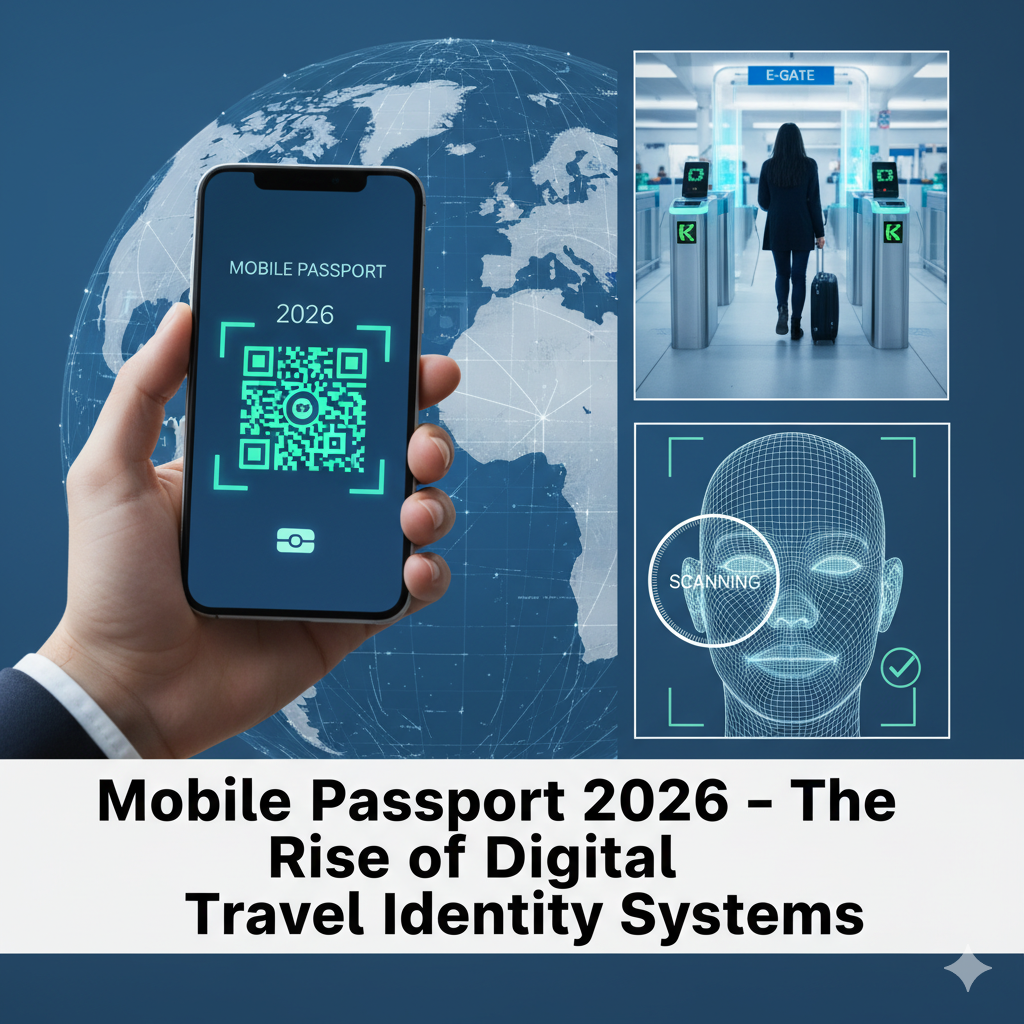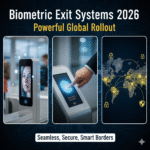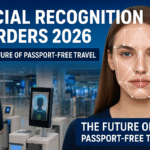The Future of Travel Is Going Fully Digital
Imagine traveling without ever reaching for your physical passport. No fumbling through documents, no lost pages, and no long queues at the immigration counter.
Welcome to Mobile Passport 2026, the next big leap in global mobility. This digital revolution combines AI, blockchain, and biometrics to create a seamless, secure, and paperless travel experience — the ultimate goal of modern border control systems.
As nations worldwide move toward smart borders, the mobile passport is becoming the foundation of international travel. Let’s dive into what’s changing, which countries are leading, and what travelers must prepare for in 2026.
What Is a Mobile Passport 2026?
The Mobile Passport is a secure digital version of your traditional travel document stored in a smartphone app. It allows travelers to submit passport information, customs declarations, and biometric data digitally — making airport processing faster and safer.
Instead of presenting a physical booklet, your digital ID is verified through a mobile device at immigration checkpoints.
Key Features:
- Encrypted digital ID stored on your device.
- Biometric authentication (face/fingerprint recognition).
- Direct data transmission to border agencies.
- Integration with e-Gates and AI-based verification systems.
- Blockchain-backed recordkeeping for tamper-proof security.
How Mobile Passport 2026 Works
In 2026, the Mobile Passport 2026 ecosystem will use AI and biometric cross-verification to confirm a traveler’s identity instantly.
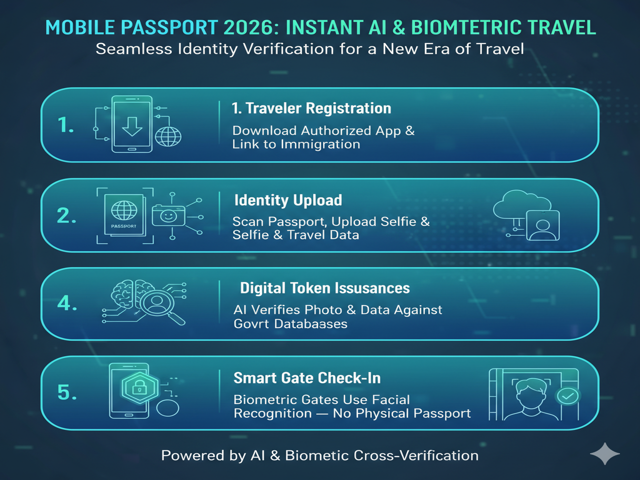
Here’s how it works:
- Traveler Registration – You download an authorized Mobile Passport app (linked to your country’s immigration system).
- Identity Upload – Scan your passport, upload your selfie, and connect your travel data.
- AI Verification – The system verifies your photo and passport data against government databases.
- Digital Token Issuance – You receive a unique encrypted travel token valid for your trip.
- Smart Gate Check-In – At the airport, you pass through biometric gates using facial recognition — no physical passport needed.
This process reduces wait times, fraud risks, and document loss, offering a more futuristic travel experience.
Countries Leading the Mobile Passport 2026 Revolution
By 2026, several countries have already begun transitioning to digital travel identity systems.
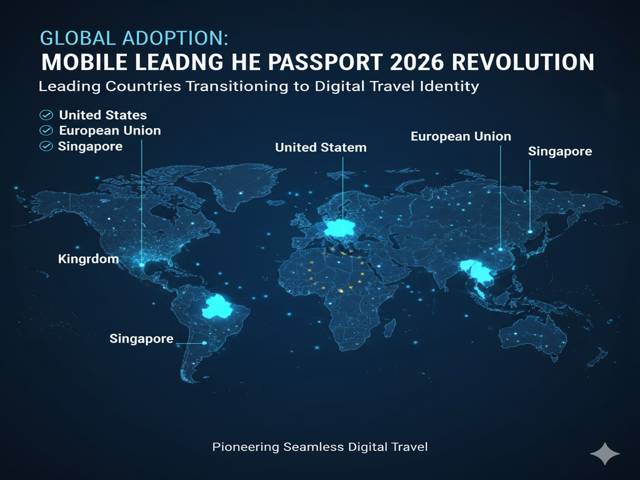
United States
- The Mobile Passport Control (MPC) app, launched by U.S. Customs and Border Protection (CBP), now supports digital-only entry at 60+ airports.
- Expected to become fully integrated with U.S. digital IDs by 2026.
United Kingdom
- The UK’s ETA system (Electronic Travel Authorization) now syncs with digital passport credentials for eligible travelers.
European Union
- Under the EU Digital Identity Wallet initiative, travelers will soon link national eIDs to border systems, creating a continent-wide mobile passport framework.
Australia
- The SmartGate program integrates facial recognition and digital travel credentials (DTCs) to replace manual passport checks.
Singapore
- The Changi Airport Smart Travel project is already testing passport-free immigration lanes for frequent flyers.
Why Mobile Passport 2026 Are the Future of Global Travel
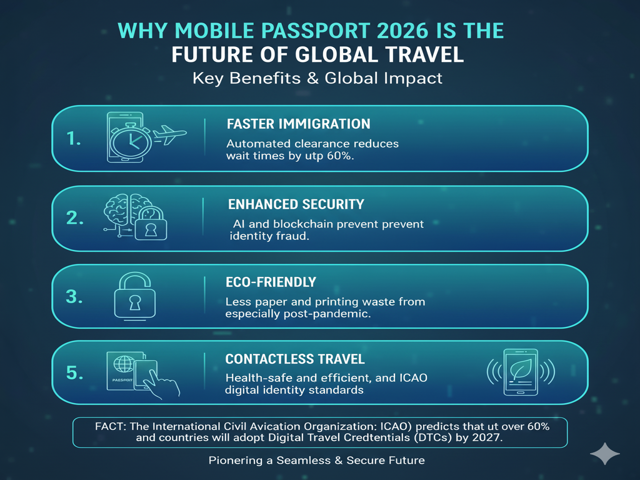
- Faster Immigration: Automated clearance reduces wait times by up to 60%.
- Enhanced Security: AI and blockchain prevent identity fraud.
- Eco-Friendly: Less paper and printing waste from physical passports.
- Contactless Travel: Health-safe and efficient, especially post-pandemic.
- Global Integration: Aligns with future UN and ICAO digital identity standards.
Fact: The International Civil Aviation Organization (ICAO) predicts that over 60% of countries will adopt Digital Travel Credentials (DTCs) by 2027.
Source: U.S. Customs and Border Protection – Mobile Passport Control
Challenges and Privacy Concerns
While digitalization sounds exciting, it also raises concerns about data misuse and surveillance.
Common Challenges:
- Cybersecurity threats: Risk of hacking or identity theft.
- Privacy issues: Governments storing biometric data in centralized systems.
- Access inequality: Travelers without smartphones or connectivity may face barriers.
- Interoperability: Different nations using incompatible systems.
Regulators are now introducing Global Digital Identity Protection Frameworks to ensure transparency and data control for travelers.
Expert Opinions
- World Economic Forum (WEF) highlights digital identity as a “critical step toward secure global mobility.”
- IATA reports that over 75% of airports plan to deploy biometric-enabled boarding by 2026.
- EU Commission emphasizes the need for privacy-first encryption in digital passports.
How Travelers Can Prepare for the Digital Passport Era
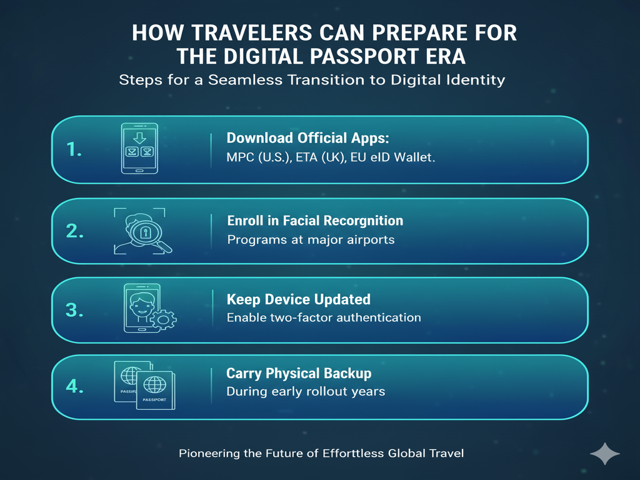
- Download official apps like MPC (U.S.), ETA (UK), or EU eID Wallet.
- Enroll in facial recognition programs at major airports.
- Keep your device updated and enable two-factor authentication.
- Carry a physical passport backup during early rollout years.
- Monitor government travel advisories for digital ID adoption schedules.
The Role of Blockchain and AI
Blockchain ensures that each traveler’s identity record is tamper-proof, while AI provides real-time fraud detection. Together, they form the backbone of border control modernization.
Expect future systems to issue “verifiable digital visas” via decentralized ledgers — meaning no more sticker or stamp visas!
Read More: EU Digital Visa System 2026: What to Expect
FAQs
Q1: Is the mobile passport the same as an e-passport?
No. An e-passport contains a digital chip, while a mobile passport 2026 lives entirely on your phone and communicates wirelessly with border systems.
Q2: Can I travel internationally without a physical passport yet?
Not entirely. Most countries still require physical passports during the transition phase, expected to end around 2028.
Q3: Is my data safe with mobile passport systems?
Yes, as long as you use official government-authorized apps with encryption and biometric security.
Q4: Which countries will adopt digital passports first?
The U.S., UK, EU, Australia, and Singapore are expected to lead by 2026.
Agent Advise
The Mobile Passport 2026 marks a powerful transformation in how humans cross borders.
From AI-based screening to blockchain-backed verification, the way we identify ourselves during travel is being rewritten.
This shift isn’t just about convenience — it’s about redefining trust, privacy, and global mobility in the digital age.
Soon, your phone might become the only passport you’ll ever need.

